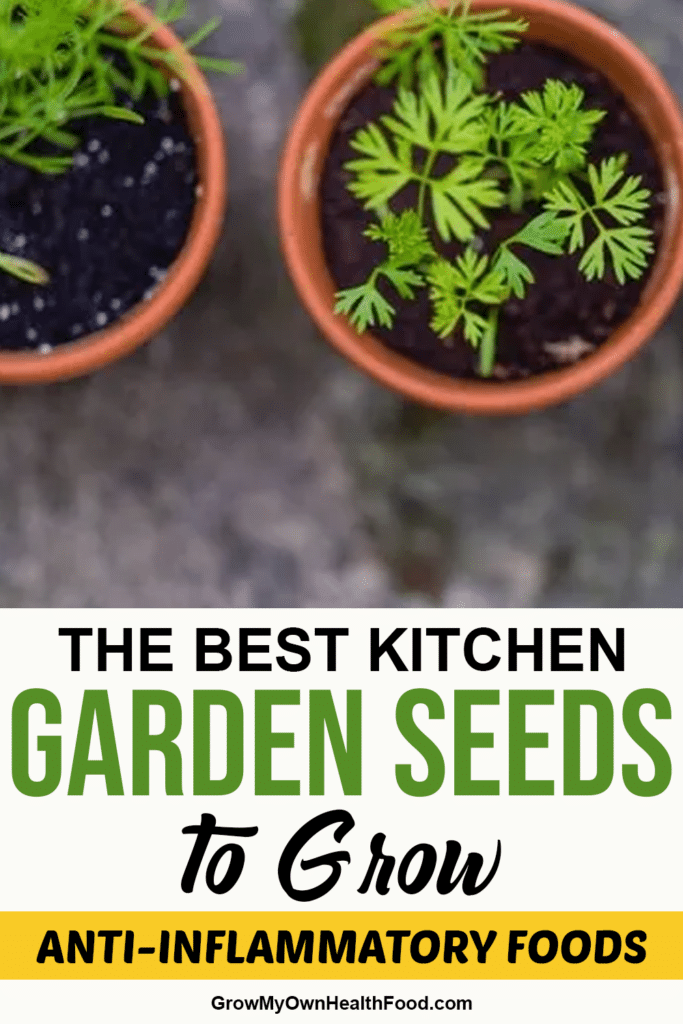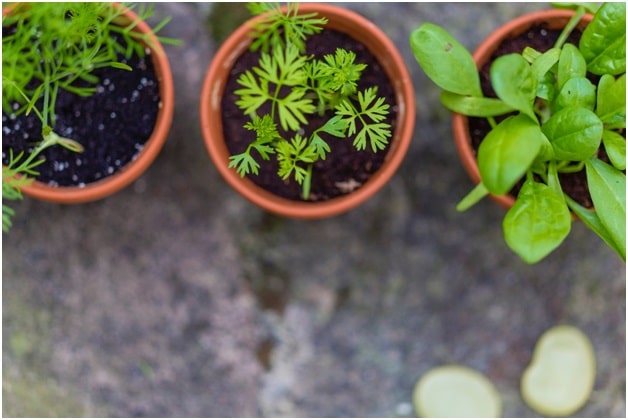Why Anti-Inflammatory?
Inflammation is a normal process in the human body. Because it facilitates healing, it is a vital response to injury or infection. It can very easily become a problem, however. Crohn’s disease, celiac disease, asthma, and rheumatoid arthritis are all strongly liked to inflammation. Inflammation also contributes to or complicates heart disease, diabetes, obesity, and cancer.
Inflammation can be managed effectively through diet. As with many diets, a variety of foods provide what you need. We have compiled a list of foods you can grow in a kitchen garden that helps you manage inflammation.
Anti-Inflammatory Leafy Greens
There is nothing like leafy greens for a healthy diet. Many varieties are available that can grow in a small indoor garden. The ones you grow at home also contain a lot more nutrients than the supermarket variety. As for the seeds, opt for 10 Varieties of Leafy Power Green Organic Seeds.
Excellent news: you can grow leafy greens in a very small space, including an apartment. The AeroGarden 45w LED Grow Light Panel allows you to seed and grow lettuce, baby spinach, and arugula.
Herbs also count as leafy greens: cilantro, oregano, mint, rosemary, parsley, basil, and sage can all play a role in a healthy, anti-inflammatory diet. Melons, broccoli, cabbage, and turnips also support an anti-inflammatory diet, but these will be more difficult to grow indoors, and impossible in a small space.
In a small apartment, and particularly while your greens are delicate seedlings, you might need your grow lighting to be a little more flexible. The LED Grow Light for Indoor Plants Sunlike Full Spectrum Grow Lamp has an adjustable gooseneck that allows you to move the light source and test different angles. The lights must be about 6 inches above the plants. Too far and the plants will reach out to get to it, which makes stems longer. Too close and the leaves might get burnt.
Anti-Inflammatory Microgreens
Some vegetable seedlings are edible and highly nutritious, with anti-inflammatory benefits – these are known as microgreens. These include radishes, mustard greens, wheatgrass, kale, broccoli, beet tops, pea shoots, and baby arugula.
Microgreens provide less fiber, but they are packed with vitamins C, E, and K, lutein, and beta-carotene. In fact, micro-greens contain up to 40 times the nutrients as their mature counterparts.
Try the Kale Trio Sprouting and Microgreen Mix for some heirloom microgreens or the Beginner’s Dozen Organic Sprouting Seeds containing alfalfa, bean salad, lentil fest, red clover, garbanzo, green lentil, green pea, mung bean, and radish.
Use a tray especially for microgreens like the Home Microgreen Soilless Hydroponics Seed Sprouter Grow Tray, which comes with a cover, spray bottle, and 20 sheets of growing paper or the Two-Tiered Seed Sprouter.
Tomatoes for Anti-Inflammation
Tomatoes need more warmth than other plants. Apparently, the top of the refrigerator provides an excellent place for them! Use heirloom seeds made especially for indoors. “Determinate” seeds grow on a bush as opposed to a vine.
Once tomatoes have grown on the bush, the bush is done. Each new crop requires a new process. “Indeterminate” seeds grow on a vine and will grow back after being picked. You will need stakes or a trellis to guide the growth of the vine.
Some more seed options:
Organic Roma Tomato Seeds
- Premium grown, harvested and packaged american non-gmo, heirloom roma tomato seeds for planting a home vegetable garden indoors or outdoor. Make a patio pot containers garden. Plant outdoor and grow for canning
- Bio degradable compostable seed packet. Product of the U.S.A. Check out our other vegetable, fruit and herb seeds like cherry tomato or beefsteak tomatoes. Oregon sugar pod II pea, romain lettuce. Or how about our mammoth sunflower or fun dwarf sunflower seeds.
- By Raw Earth Colors.
Prices pulled from the Amazon Product Advertising API on:
Product prices and availability are accurate as of the date/time indicated and are subject to change. Any price and availability information displayed on [relevant Amazon Site(s), as applicable] at the time of purchase will apply to the purchase of this product.
Burpee Fourth of July Hybrid Red Slicing Tomato Seeds
- Burpee exclusive. The first Tomato to ripen by independence day! indeterminate plants produce fruits that average 4 oz. All season long. Indeterminate
- Each packet contains 50 seeds
- Sow indoors 6-8 weeks before average last frost date using a Burpee seed starting kit. Transplant to the garden 4 weeks after the average last frost date. Harvest in 49 days
- Plant Height is 55. plant spread is 55. yields 4 fruit
- Annual for all growing zones from 1-11. Sunlight exposure = full-sun
- Find over 1000 Burpee vegetable, herb, and flower seeds on Amazon
- Get your seeds off to a great start with a Burpee Seed Starting Kit
- Burpee, the gardener’s best friend since 1876. Beautiful plants and everything else you need to grow the garden of your dreams from America’s most trusted seed company. No GMOs, ev
Prices pulled from the Amazon Product Advertising API on:
Product prices and availability are accurate as of the date/time indicated and are subject to change. Any price and availability information displayed on [relevant Amazon Site(s), as applicable] at the time of purchase will apply to the purchase of this product.
Provide a moist atmosphere for your tomato plants. They will also need the equivalent of eight hours of sunlight. Use potting mix and fresh water. Sow the seeds five millimeters deep in potting mix. To maintain moisture levels, cover the starter trays with foil and plastic wraps.
Transfer the seedlings to pots – take care not to damage the roots. Monitor the new pots for moisture. Avoid letting the soil get dry and hard. Tomatoes will be ready to harvest within about 70 days.
Strawberries – The Anti-Inflammation Berry
Strawberries, blueberries, cherries, and oranges all contribute to reduced inflammation. Out of those, the most practical one to grow indoors is strawberries. Root plants allow you to plant strawberries at home – these are known as Honeoye. These are easy to grow indoors but might not be as sweet as strawberries you’re used to.
Strawberries do well when you plant them in specially designed bags or stackable pots – these are also good for a smaller space. Check out:
Reeyox Strawberry Grow Bag
- 【Innovative Design】Reeyox strawberry grows bag design with 8 side pockets, perfect for Strawberries shallow roots. Plus you can add even more plants to the open top. Reinforced handle allows you to move it easily.
- 【Breathable Material】Made of double-layered thick non-woven fabric, which is lightweight and breathable. It makes the roots extend freely, get more oxygen, percolates the excess water quickly, and creates a stable growing environment for planting and growing.
- 【Durable & Reusable】The planting bags are made of premium material, sturdy enough for reusable use. You can repeat planting other vegetables after finished. Grow bags fold for storage and are reusable year after year.
- 【Scope of application】It can not only grow strawberry but also grow a variety of plant, like vegetables, herbs, flowers. It has a wide range of uses and works very well. Because its structure design is unique and suitable for all kinds of plant.
- 【After-sales guarantee】We are desired to provide best quality product and the best customer service for every customer, if you have any problem with our products, please feel free to contact us, we will reply you in 24 hours. Our pursuit is your 100% satisfact
Prices pulled from the Amazon Product Advertising API on:
Product prices and availability are accurate as of the date/time indicated and are subject to change. Any price and availability information displayed on [relevant Amazon Site(s), as applicable] at the time of purchase will apply to the purchase of this product.
5-Tier Strawberry and Herb Garden Planter
- Stackable plan
Prices pulled from the Amazon Product Advertising API on:
Product prices and availability are accurate as of the date/time indicated and are subject to change. Any price and availability information displayed on [relevant Amazon Site(s), as applicable] at the time of purchase will apply to the purchase of this product.
For more detailed instructions on growing strawberries, consult our previous article, The Top 6 Secrets of Growing Strawberries Indoors Year Round.
Quick Recipes for the Anti-Inflammatory (Indoor Grown) Diet
Combine microgreens with the strawberries! Here are two quick recipes:
Mini Strawberry Chocolate Tart with Whipped Goat Cheese and Basil Micro Greens
You will find that the strawberries and microgreens used together in this recipe compliment each other beautifully. Microgreens are a great source of beneficial plant compounds with more concentrated nutrient content and higher vitamin, mineral, and antioxidant levels when compared with mature greens.
Summer is winding down as we head into the cooler fall months. With the change in weather, we often start craving warmer foods. This end of summer salad is the perfect beginning to fall and features nutrient-rich foods that can help your body contend with all the seasonal changes.
Other Things You Can Add to an Anti-Inflammatory Diet
All of the following foods can support and provide variety for an anti-inflammatory diet:
- Olive oil
- Nuts including almonds and walnuts
- Fatty fish like salmon, mackerel, tuna, and sardines
- Blueberries
- Cherries
- Oranges
- You can also add bigger leafy greens that are more difficult to grow indoors like cabbage, swiss chard, and rutabagas
If you’re serious about it, you can further support your goal by avoiding the following foods:
- Pop and sugary juices
- Refined carbohydrates like white bread and white bread pasta
- Margarine and lard
- French fries and other deep-fried food
- Red meat like what you find in hamburgers, steaks, hot dogs, and sausage







